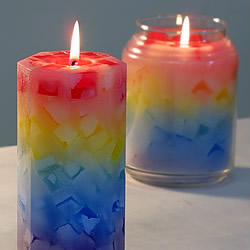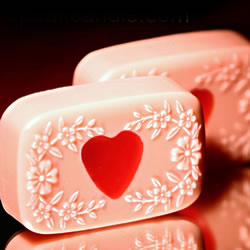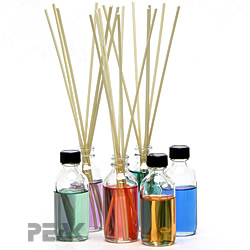Reed diffusers draw diffuser oil from the bottles up into the reeds, allowing the scent to disperse into the surrounding air. They offer an attractive alternative to scented candles in situations where an open flame is not desired or permitted. There are no flames involved, and they are very easy to make.
The diffuser oil is made by mixing diffuser base with your choice of fragrance oil. Typical formulations call for about 25% fragrance oil mixed with 75% diffuser base, but you may wish to experiment with other ratios. The diffuser base is a very light oil that contains no alcohol. The base mixes well with fragrance oils and enhances the capilary action, encouraging the diffuser oil to travel up the reed diffuser sticks where the scent can be effectively dispersed into the environment. A formulation with too much fragrance oil will not effectively migrate up the reeds, and will hinder effective scent dispersion.
![reed305[1]](/wp-content/uploads/2013/08/reed3051.jpg) The reeds offered by Peak are made of premium rattan. Rattan is hollow, thus allowing the diffuser oil to easily migrate up the core of the reed. Each of our 10″ reeds has approximately 3.7 square inches of surface area. A half a dozen reeds provides more surface area than a 4″ apothecary jar, resulting in excellent scent dispersion.
The reeds offered by Peak are made of premium rattan. Rattan is hollow, thus allowing the diffuser oil to easily migrate up the core of the reed. Each of our 10″ reeds has approximately 3.7 square inches of surface area. A half a dozen reeds provides more surface area than a 4″ apothecary jar, resulting in excellent scent dispersion.
These reed diffuser oils were formulated by mixing fragrance oil, diffuser base, and a very small amount of liquid candle dye for tinting. The dye is optional, but gives the oils some visual appeal when combined with the clear boston round bottles.
Retailers typically charge from $15 to $40 for a package that generally includes a glass bottle, several ounces of formulated diffuser oil, and a dozen diffuser reeds.
![2ozwithreed600_5278[1]](/wp-content/uploads/2013/08/2ozwithreed600_52781.jpg)
![2ozbostonrounds600_5275[1]](/wp-content/uploads/2013/08/2ozbostonrounds600_52751.jpg)




Sweet,,,!!:-)
Can you use reed diffuser oil for making candles?
You asked: Can you use reed diffuser oil for making candles: NO, I tried this!!! I just assumed it would work well. Bought Pier 1 “Asian Spice” reed diffuser oil. Melted soy-wax-flakes from Michaels. Added several tablespoons of reed diffuser oil into the melted wax, and poured into containers (with wicks in place.) WHEN LIT this combination created a huge flame that spread out 2″(total) in diameter beyond the wick (1″ beyond the wick all around) a black messy garbage pile of burning material. A total failure. To salvage, I am just using the wax as a “wax melt” in a stainless steel pan on the stove, and not trying to burn (light) it. A candle FAILURE!.